
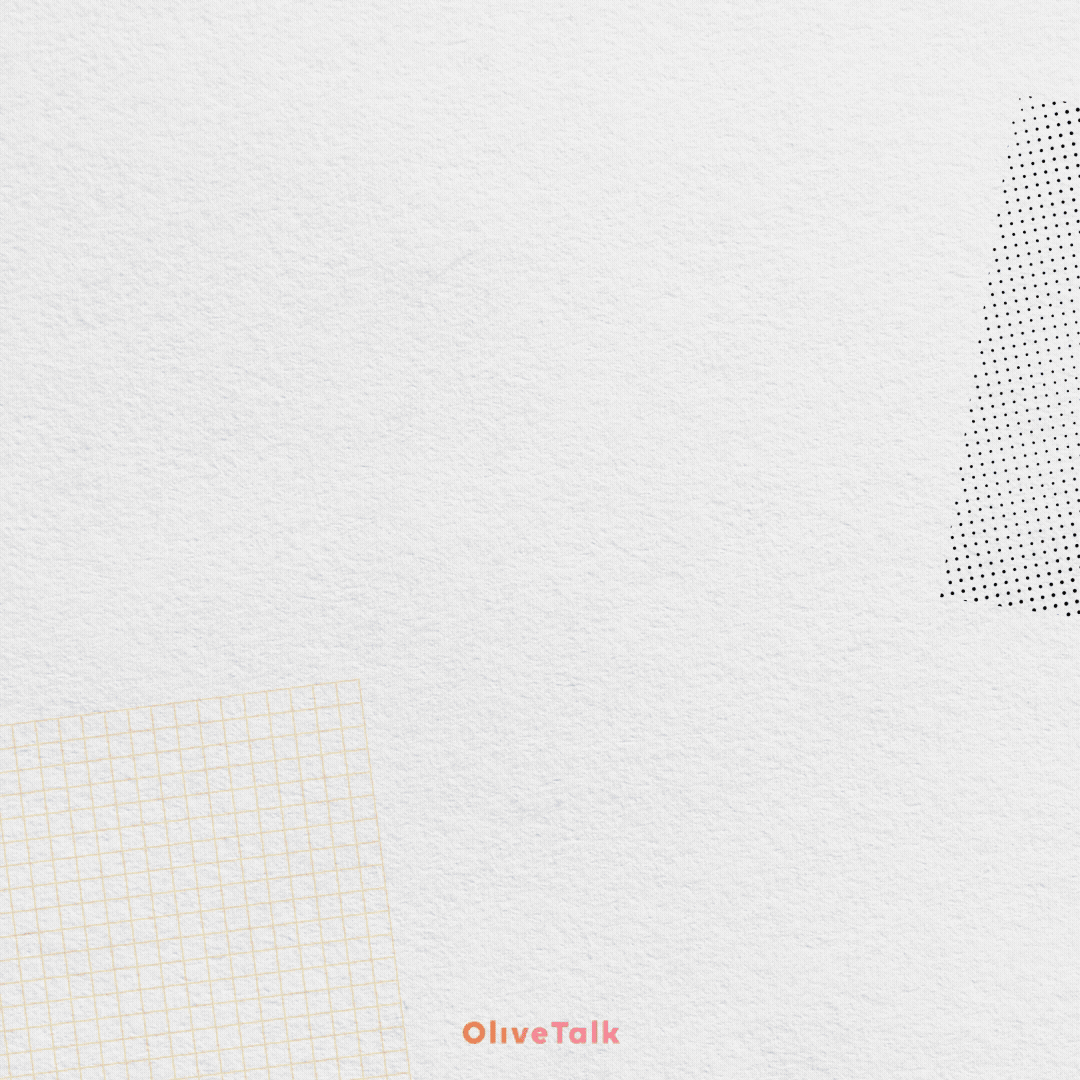
🧪 What Are AHA & BHA?
Alpha Hydroxy Acids (AHAs) are water-soluble acids like glycolic, lactic, and mandelic acid that exfoliate the surface of the skin by dissolving bonds between dead cells.
Beta Hydroxy Acid (BHA), primarily salicylic acid, is oil-soluble and works deeper inside pores, making it a top pick for acne-prone and oily skin.
INCI Names
- Glycolic Acid, Lactic Acid, Mandelic Acid (AHAs)
- Salicylic Acid (BHA)
1. What Are the Sources of AHA & BHA?
*AHAs (Alpha Hydroxy Acids) are naturally derived from fruits, milk, and sugar sources think of them as nature’s resurfacing agents.
- Glycolic Acid → From sugarcane
- Lactic Acid → From sour milk or fermented vegetables
- Mandelic Acid → From bitter almonds
- Malic & Tartaric Acids → From apples and grapes
*BHA (Beta Hydroxy Acid) typically salicylic acid is originally derived from willow bark, birch, or wintergreen leaves. It’s closely related to aspirin (acetylsalicylic acid), which explains its anti-inflammatory powers.
So yes, your exfoliants are basically fruit acids and botanical extracts reimagined for high-performance skincare.
2. Why Are AHA & BHA Often Used Together?
Great question! AHA and BHA are often formulated together because they complement each other beautifully 1)AHAs work on the surface great for smoothing and brightening, 2)BHA goes deeper into the pore excellent for oil and acne control
Think of it like a tag team : one cleans up the top layer, the other clears out below. This combo offers multi-level exfoliation and is especially effective for people dealing with both dullness and breakouts.
📌 Tip: Korean and Western skincare brands both love this pairing in exfoliating toners, pads, and serums and for good reason.
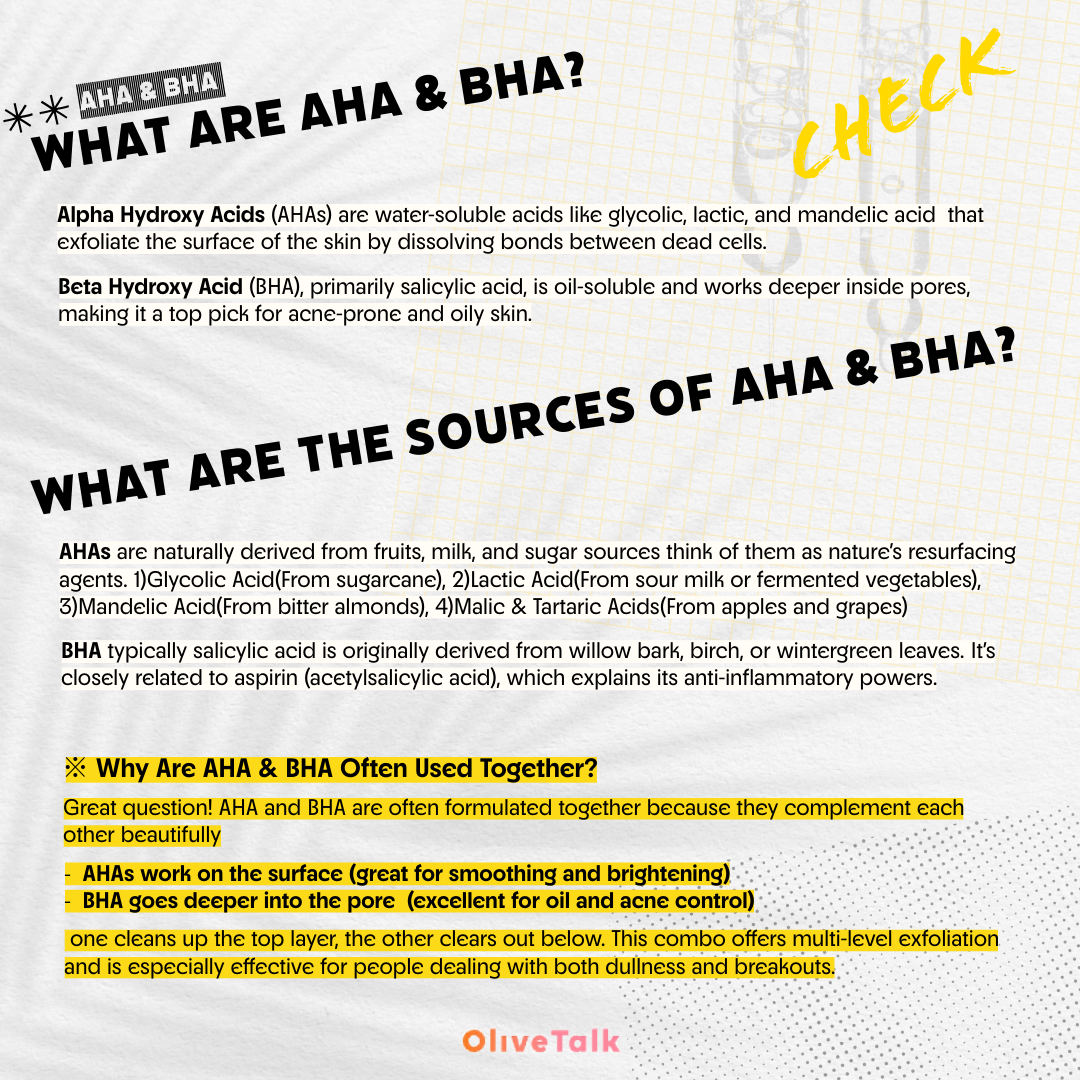
🌱 Origins of AHA & BHA in Skincare
AHA use can be traced back to ancient Egypt, where Cleopatra used sour milk (lactic acid) for smoother skin. Modern cosmetic chemistry embraced glycolic acid in the 1970s.
BHA (salicylic acid) has its roots in willow bark, used for centuries in medicinal applications. Its keratolytic properties became a dermatological gold standard in the late 20th century.
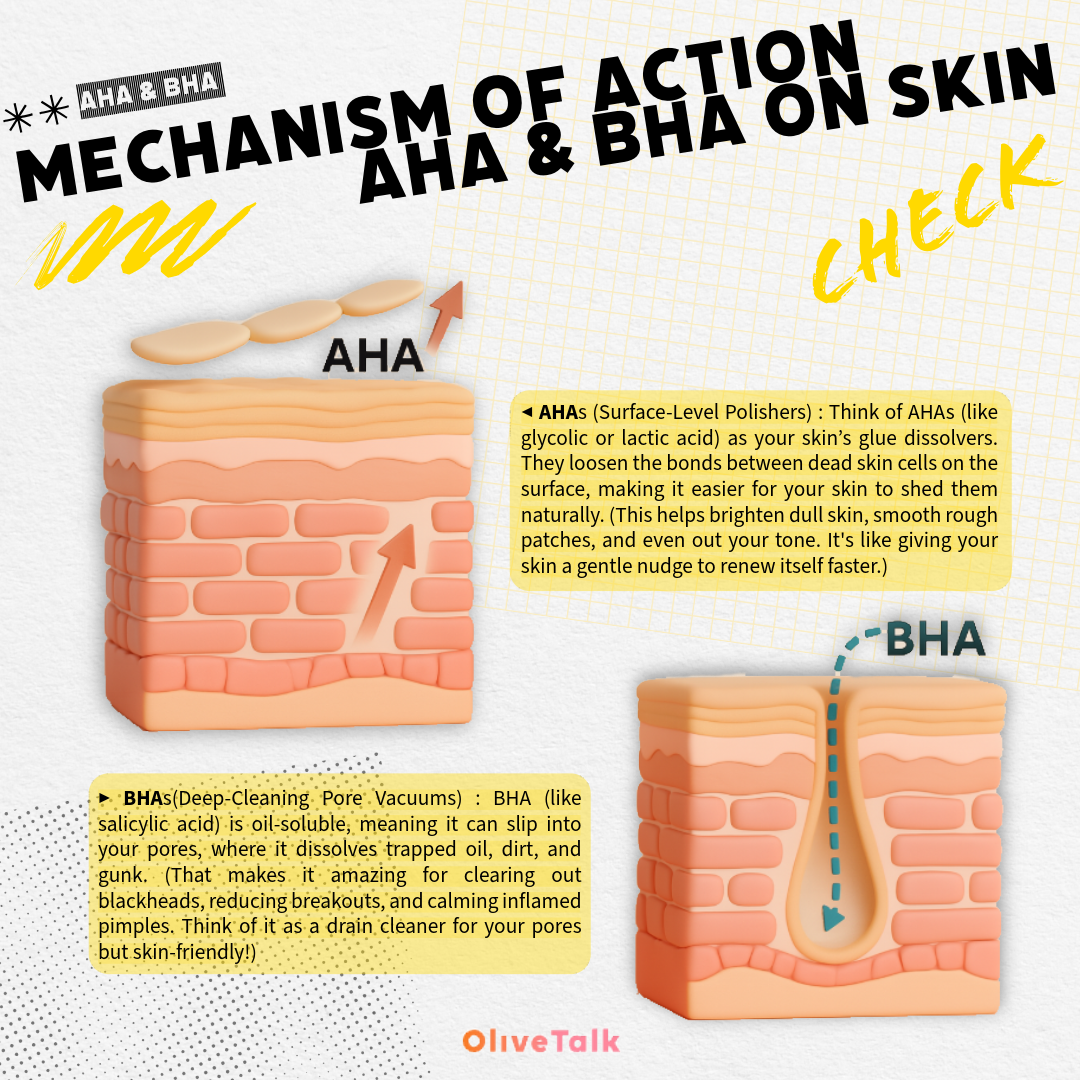
🔬Mechanism of Action (How AHA & BHA Work)
AHAs weaken corneocyte cohesion in the stratum corneum → accelerates exfoliation → promotes even tone & texture
BHAs penetrate sebaceous follicles → dissolve sebum + debris → reduce clogged pores, blackheads, and acne
Both stimulate cell turnover and increase dermal thickness over time (when used consistently)
📖 Reference: Van Scott, E. J., & Yu, R. J. (1989). Alpha Hydroxy Acids: Skin rejuvenation mechanisms. Journal of the American Academy of Dermatology.
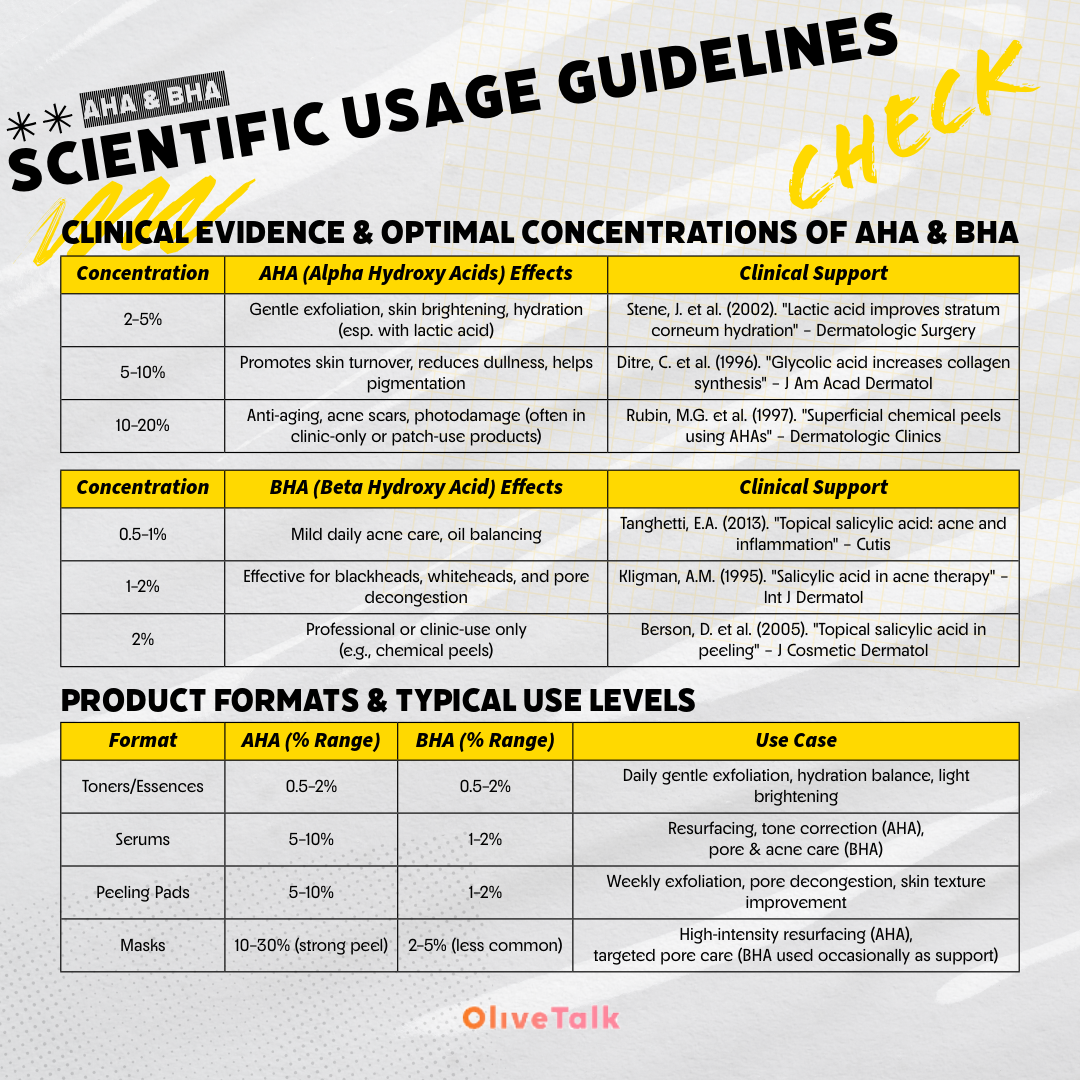
📊 Clinical Evidence & Optimal Concentrations of AHA & BHA
※ AHA (Alpha Hydroxy Acids) Common Types : Glycolic Acid, Lactic Acid, Mandelic Acid
(Concentration / Effects / Clinical Support)
- 2–5% / Gentle exfoliation, skin brightening, hydration (esp. with lactic acid) / Stene, J. et al. (2002). "Lactic acid improves stratum corneum hydration" – Dermatologic Surgery
- 5–10% / Promotes skin turnover, reduces dullness, helps pigmentation / Ditre, C. et al. (1996). "Glycolic acid increases collagen synthesis" – J Am Acad Dermatol
- 10–20% / Anti-aging, acne scars, photodamage (often in clinic-only or patch-use products) / Rubin, M.G. et al. (1997). "Superficial chemical peels using AHAs" – Dermatologic Clinics
✅ Clinical Insight : Glycolic acid is the most researched AHA. It has the smallest molecule size → deeper epidermal penetration.
❗ Caution: Over 10% can increase irritation risk always pair with barrier support like ceramides or panthenol.
※ BHA (Beta Hydroxy Acid) Main Type: Salicylic Acid
(Concentration / Effects / Clinical Support)
- 0.5–1% / Mild daily acne care, oil balancing / Tanghetti, E.A. (2013). "Topical salicylic acid: acne and inflammation" – Cutis
- 1–2% / Effective for blackheads, whiteheads, and pore decongestion / Kligman, A.M. (1995). "Salicylic acid in acne therapy" – Int J Dermatol
- >2% / Professional or clinic-use only (e.g., chemical peels) / Berson, D. et al. (2005). "Topical salicylic acid in peeling" – J Cosmetic Dermatol
✅ Clinical Insight: BHA is oil-soluble penetrates into pores, dissolves sebum and keratin plugs.
💡 Bonus: BHA also has natural anti-inflammatory and photoprotective properties (helps calm redness and reduce sun damage over time).
🧴 AHA vs. BHA (Product Formats & Typical Use Levels)
(Product Format / AHA (% Range) / BHA (% Range) / Primary Use Cases)
- Toners, Essences / 0.5–2% / 0.5–2% / Daily gentle exfoliation, hydration balance, light brightening)
- Serums / 5–10% / 1–2% / Resurfacing, tone correction (AHA), pore & acne care (BHA)
- Peeling Pads / 5–10% / 1–2% / Weekly exfoliation, pore decongestion, skin texture improvement
- Masks / 10–30% (strong peel) / 2–5% (less common) / High-intensity resurfacing (AHA), targeted pore care (BHA used occasionally as support)
📚 Key References
1) Ditre, C.M. et al. (1996). Effects of alpha hydroxy acids on photoaged skin. J Am Acad Dermatol.
2) Rubin, M.G. et al. (1997). Superficial chemical peels using AHAs. Dermatol Clin.
3) Tanghetti, E.A. (2013). The role of inflammation in the pathology of acne. Cutis.
4) Kligman, A.M. (1995). Topical salicylic acid in acne management. Int J Dermatol.
5) Berson, D.S. et al. (2005). Chemical peeling: salicylic acid-based agents. J Cosmet Dermatol.
6) Stene, J. et al. (2002). Lactic acid as a humectant in dry skin treatment. Dermatol Surg.
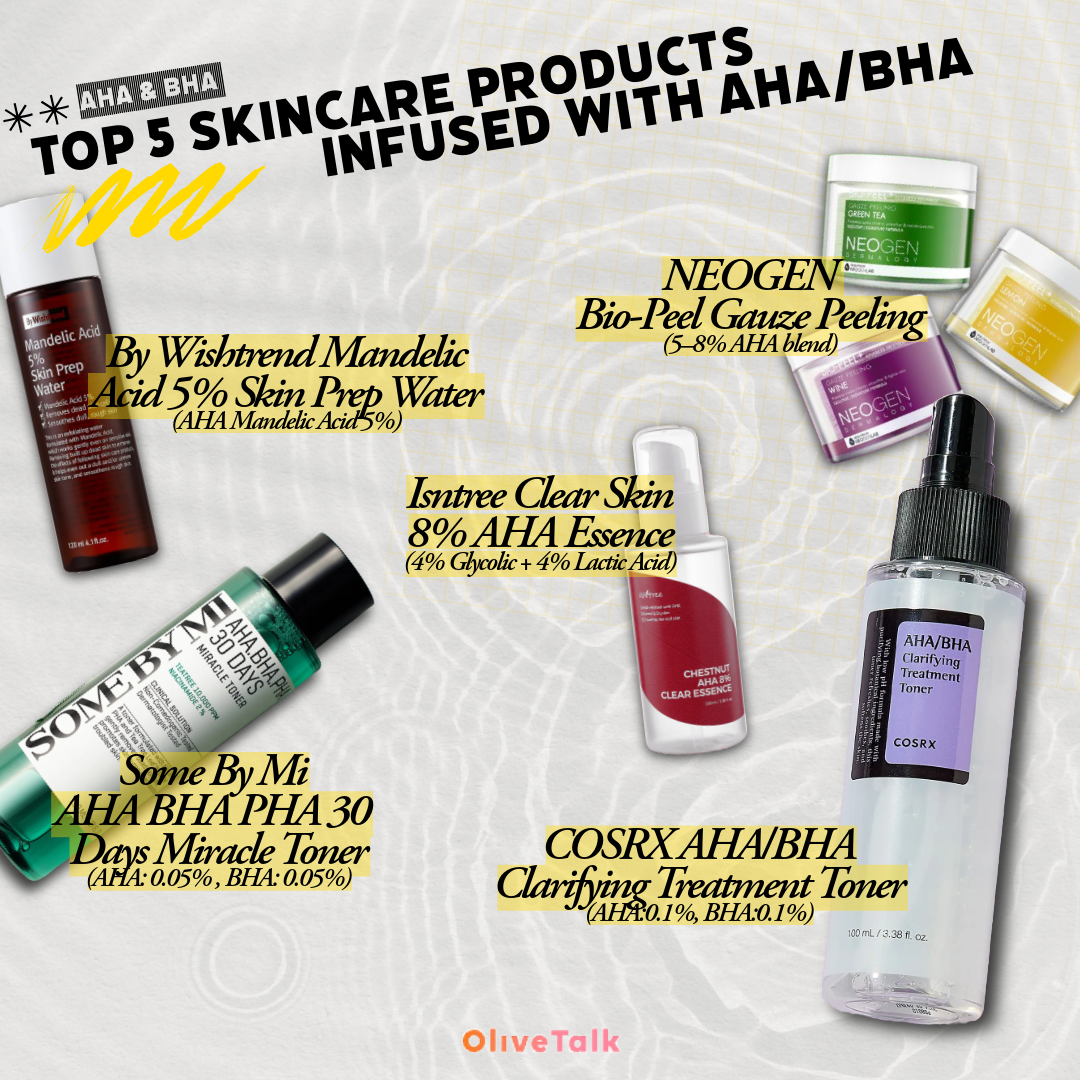
<Top 5 Skincare Products Infused with AHA/BHA>
1. COSRX AHA/BHA Clarifying Treatment Toner
Content : Glycolic Acid (0.1%), Salicylic Acid (0.1%)
Country : KR
2. Some By Mi AHA BHA PHA 30 Days Miracle Toner
Content : AHA: 0.05% (Lactic), BHA: 0.05% (Willow Bark derived)
Country : KR
3. NEOGEN Bio-Peel Gauze Peeling (Wine/Lemon/Green Tea)
Content : Estimated 5–8% AHA blend (Glycolic/Lactic)
Country : KR
4. By Wishtrend Mandelic Acid 5% Skin Prep Water
Content : Mandelic Acid 5%
Country : KR
5. Isntree Clear Skin 8% AHA Essence
Content : 4% Glycolic + 4% Lactic Acid
Country : KR
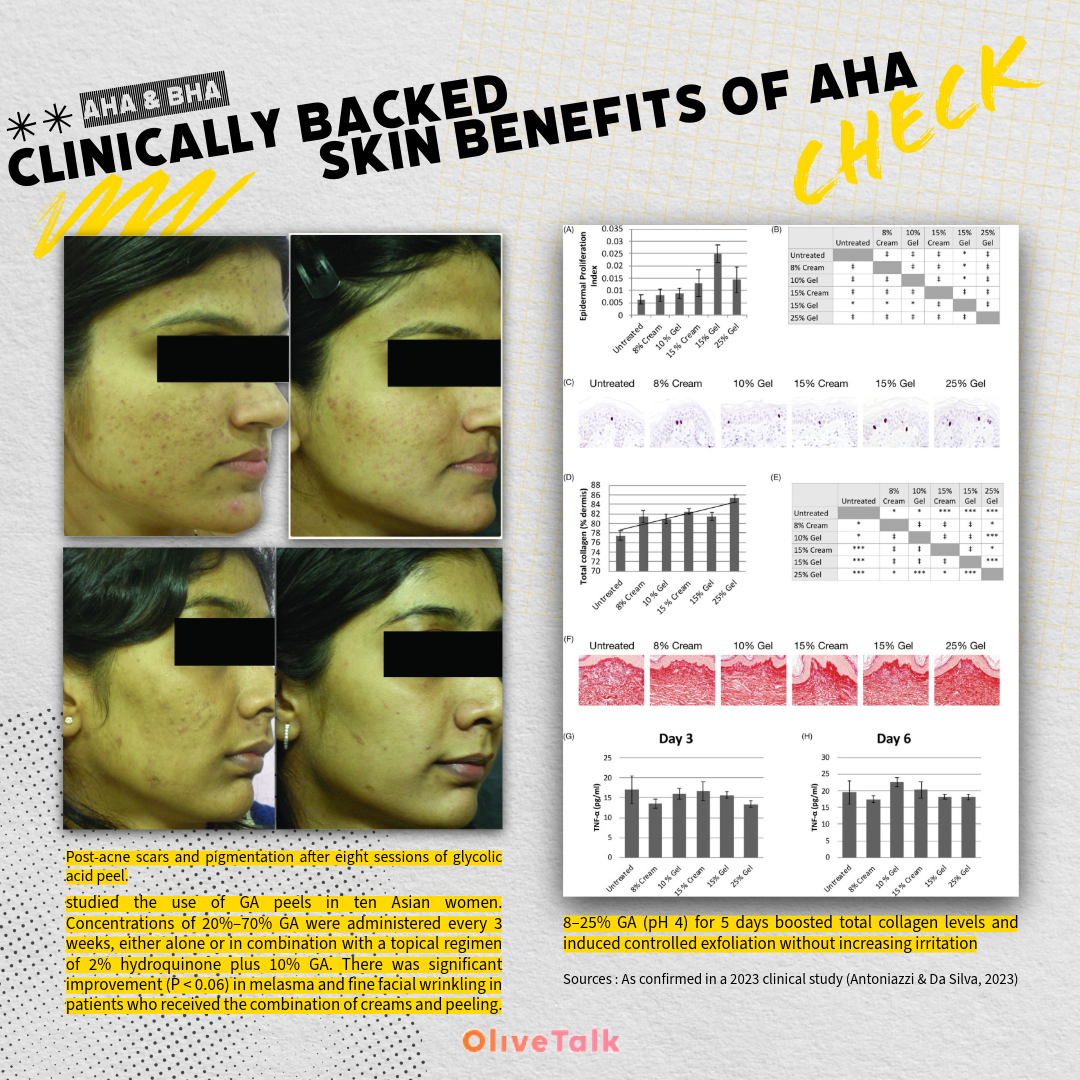
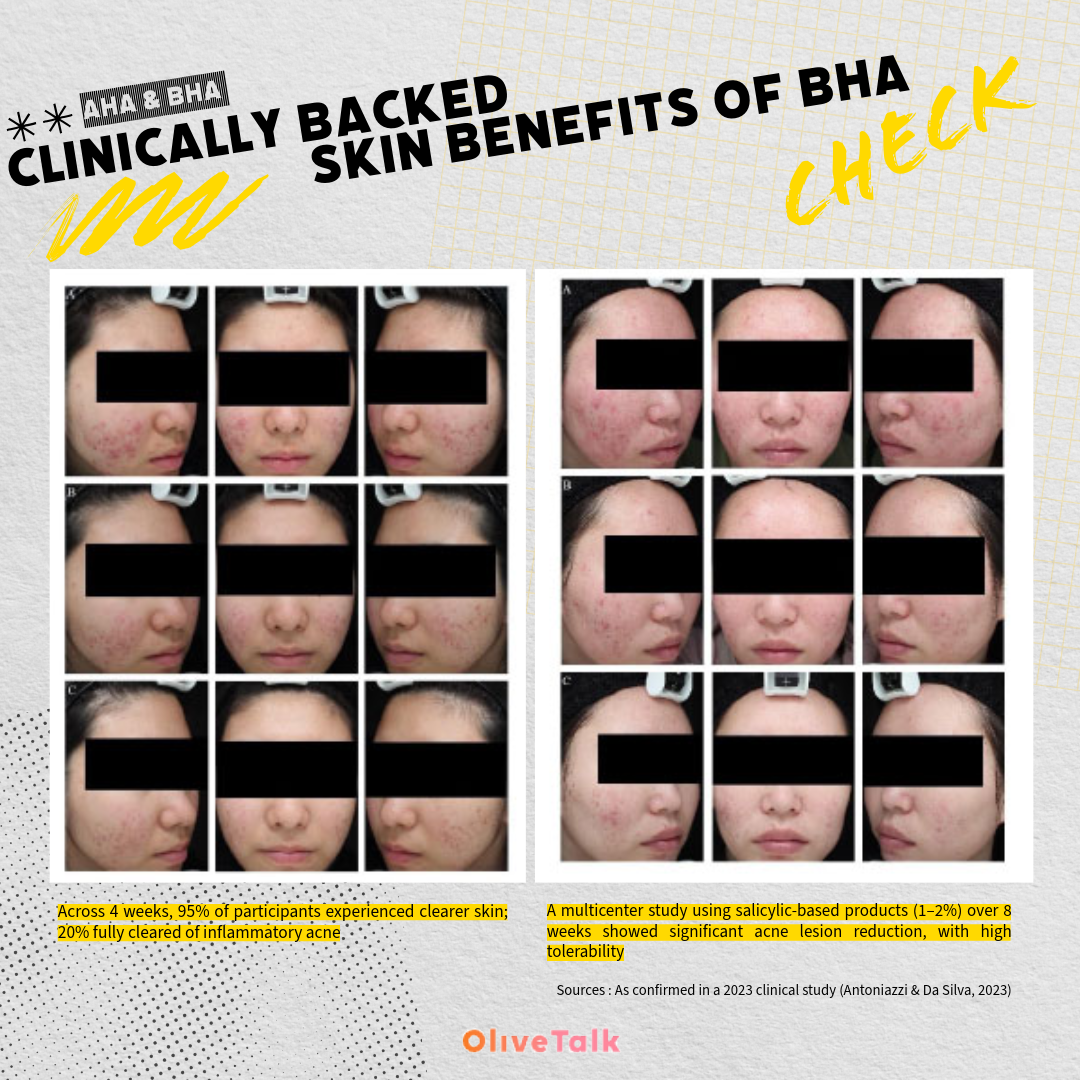
📚 Clinical Efficacy
Glycolic Acid (8–10%) shown to improve photoaged skin texture in 6–8 weeks
(Ditre, C. M. et al., 1996. Journal of the American Academy of Dermatology)
Salicylic Acid (2%) effectively treats acne, reduces comedones
(Kligman, A. M., 1986. Dermatologic Clinics)
Combination AHA/BHA regimens improve texture, clarity, and reduce pigmentation
(Brennan, M. T. et al., 2003. Cutis)
🏛️ Historical Note
Once exclusive to dermatology clinics, AHA/BHA technology is now in everything from drugstore toners to luxury peels. Korean brands, in particular, have innovated with low-irritation, multi-acid formulations suitable for sensitive skin.
💾 Pro Tips from a Skincare Expert
1) Start slow: 2–3x/week with lower % to build tolerance
2) Avoid layering with strong retinoids or low pH vitamin C too much irritation risk!
3) Always apply broad-spectrum SPF when using exfoliants AHAs increase photosensitivity
4) Pair with hydrators like panthenol or beta-glucan to buffer dryness
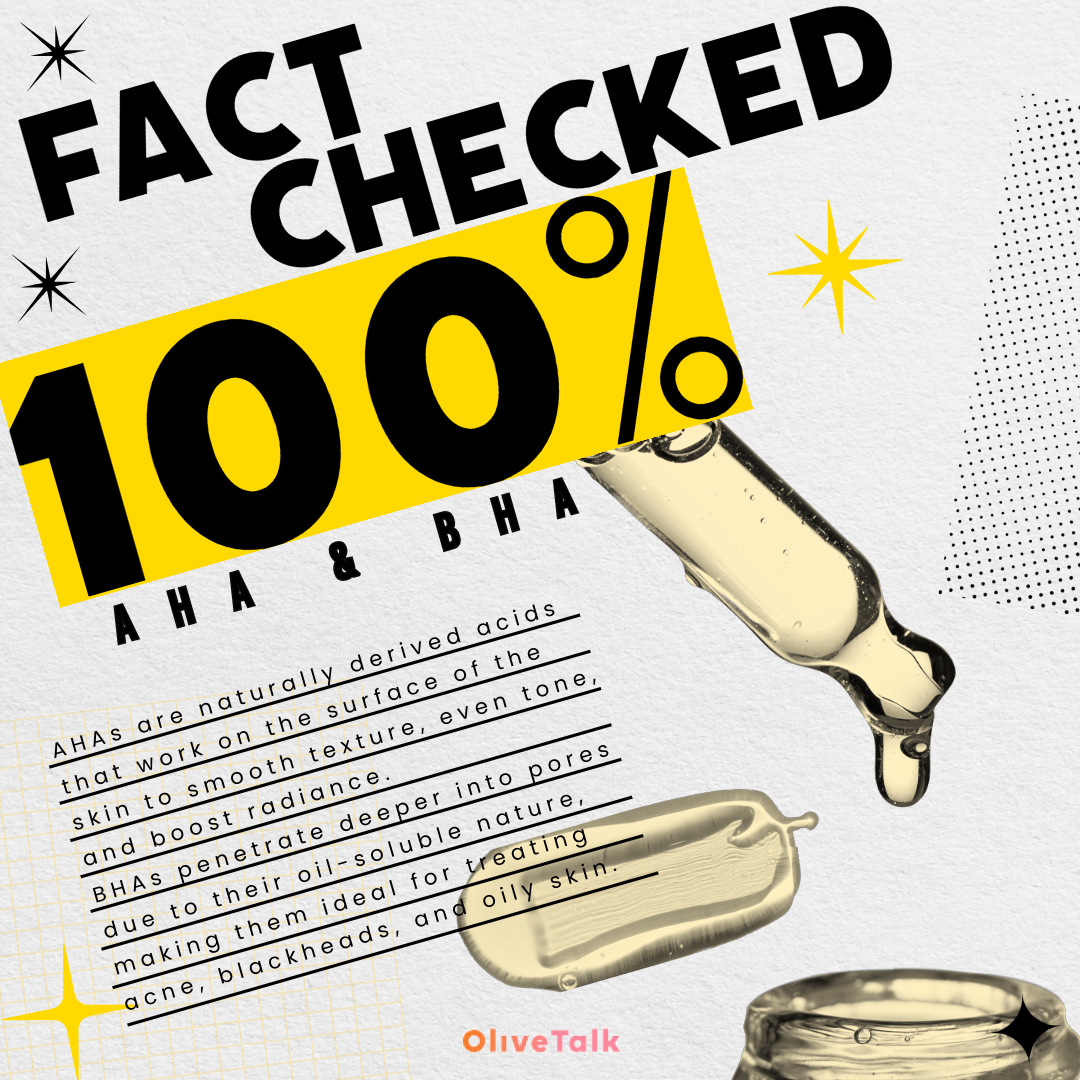
📚 References
1. Van Scott EJ, Yu RJ. (1989). Alpha Hydroxy Acids and skin rejuvenation. JAAD.
2. Ditre CM et al. (1996). Glycolic acid for photoaged skin. JAAD.
3. Kligman AM. (1986). Salicylic acid in acne therapy. Dermatol Clin.
4. Draelos ZD. (2001). Cosmeceuticals with AHAs and BHAs. J Cosmet Dermatol.
5. Berson DS, Cohen JL. (2012). Cosmetic benefits of AHAs/BHAs. Cutis.
 17Comments
17Comments-
 Influencer13 hr. agoI was always confused about the differences between aha and bha🤔🤔 ty for a great explanation!!
Influencer13 hr. agoI was always confused about the differences between aha and bha🤔🤔 ty for a great explanation!! -
 Influencer12 hr. agoI am using the isntree essence one!!! It's soooooooo nice😍😍
Influencer12 hr. agoI am using the isntree essence one!!! It's soooooooo nice😍😍 Influencer12 hr. agoCan u plz tell me a cream that u pair with it???
Influencer12 hr. agoCan u plz tell me a cream that u pair with it??? Influencer12 hr. agoSureeeeee😁 I use a moisturizer from s.nature
Influencer12 hr. agoSureeeeee😁 I use a moisturizer from s.nature -
 Guest12 hr. agoOmg i didnt know that aha and bha have been used since that long ago.....
Guest12 hr. agoOmg i didnt know that aha and bha have been used since that long ago..... -
 Influencer12 hr. agoGuys plz start from using low concentration products if ur skin is sensitive!!! It can be irritating if u use a strong one from the beginning
Influencer12 hr. agoGuys plz start from using low concentration products if ur skin is sensitive!!! It can be irritating if u use a strong one from the beginning Influencer12 hr. agoFr😭😭😭😭😭
Influencer12 hr. agoFr😭😭😭😭😭 Influencer12 hr. agoIs the corsx toner on the recommendation above ok for a beginner??
Influencer12 hr. agoIs the corsx toner on the recommendation above ok for a beginner?? Influencer12 hr. ago@Influencer Ive never used it before so idk exactly but i think its concentration is low enough for a beginner?
Influencer12 hr. ago@Influencer Ive never used it before so idk exactly but i think its concentration is low enough for a beginner? Influencer12 hr. ago@Influencer Thx!!😊😊
Influencer12 hr. ago@Influencer Thx!!😊😊 -
 Guest12 hr. agoI didn't know that they work better together. I was using bha only! I should go get some aha too😚😚😚
Guest12 hr. agoI didn't know that they work better together. I was using bha only! I should go get some aha too😚😚😚 -
 Guest11 hr. agoThx for the info!!👍
Guest11 hr. agoThx for the info!!👍 -
 Influencer10 hr. agoI wonder why all ingredients sounds so effective when u read the researches but it's not that dramatic for me..
Influencer10 hr. agoI wonder why all ingredients sounds so effective when u read the researches but it's not that dramatic for me.. Guest10 hr. agoMe too 😭😭😭 I mean, how did they even get the results...
Guest10 hr. agoMe too 😭😭😭 I mean, how did they even get the results... -
 Guest10 hr. agoIt's actually interesting that aha can work for anti aging in high concentration 😲
Guest10 hr. agoIt's actually interesting that aha can work for anti aging in high concentration 😲 Influencer10 hr. agoYess but u should always be careful when u use a product with high concentration!
Influencer10 hr. agoYess but u should always be careful when u use a product with high concentration! -
 Influencer10 hr. agoSo u mean they can help with skin brightening, hydration, acne scars, acne soothing, and anti aging?? Sounds too ideal for me...
Influencer10 hr. agoSo u mean they can help with skin brightening, hydration, acne scars, acne soothing, and anti aging?? Sounds too ideal for me...